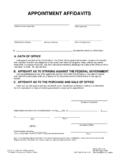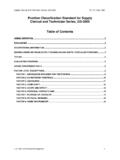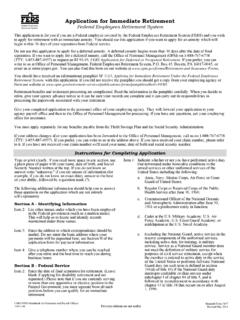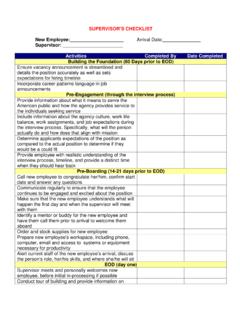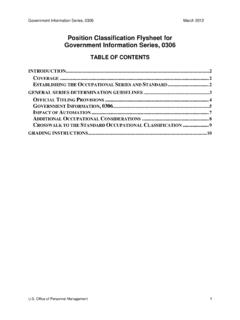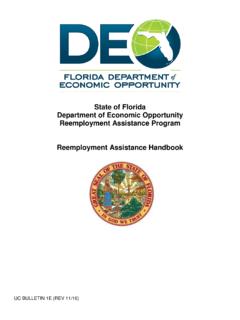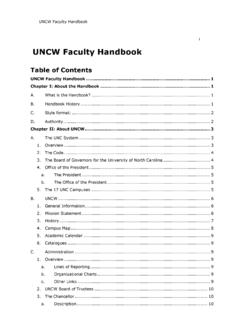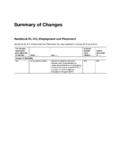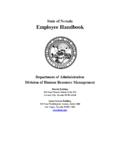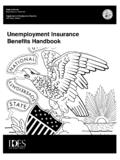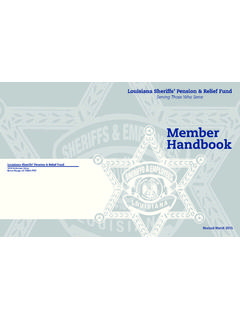Transcription of Workforce Reshaping Handbook - OPM.gov
1 MARCH 2017 Workforce ReshapingOperations Handbook A Guide for Agency Managementand Human Resource OfficesUnited StateS Office Of PerSOnnel ManageMent Table of Contents Purpose of the Workforce Reshaping Operations 3 Audience .. 3 Materials needed .. 3 How the Handbook is 3 Chapter I: Management s Role and 4 Section A: Developing, Reviewing, and Analyzing Mission Requirements .. 4 Section B: Identifying Critical Management Considerations When Reshaping .
2 5 Section C: Minimizing the Need for Reduction in Force as a Result of Reshaping 6 Section D: Deciding Whether to Implement a 12 Section E: Communicating the Reshaping 12 Chapter II: Human Resource s Role and 13 Section A: Establishing the Human Resources Office s RIF Team .. 13 Section B: Taking Preliminary Actions .. 19 Section C: Preparing and Using Retention Registers .. 19 Section D: Determining Rights to Other 19 Section E: Issuing RIF 20 Section F: Counseling Employees on Procedures and 21 Chapter III: Reduction in 22 Section A: Management Rights .. 22 Section B: Compliance with the RIF Regulations .. 23 Section C: Coverage of the RIF Regulations .. 23 Section D: Reorganization, Misclassification, and Job Erosion.
3 28 Section E: Competitive 29 Section F: Competitive 33 Section G: Establishing Retention 38 Section H: Determining Employees Retention 39 Section I: Retention Tenure 40 Section J: Veterans Preference in 42 Section K: RIF Service 44 Section L: Additional RIF Service Credit for Performance .. 45 Section M: Personnel Records in 51 Section N: Release From the Competitive Level .. 52 Section O: Actions Following Release From the Competitive 58 Section P: Determining Employees Assignment Rights .. 58 Section Q: Bump and Retreat for Assignment .. 62 Section R: Vacancies for 64 Section S: Vacant Temporary Positions as Placement Offers .. 68 Section T: Consideration of Grades in 69 Section U: Consideration of Representative Rates in Assignment.
4 73 Section V: Consideration of Qualifications in 74 Section W: Trainee and Developmental Positions for 78 Section X: Consideration of Security Clearances in 80 Section Y: Administrative Assignment Options .. 81 Section Z-1: RIF Notices to 82 Section Z-2: Additional Notice Requirements for RIF 86 Section Z-3: Requesting an Exception to the Minimum RIF Notice Period .. 87 Section Z-4: Certification of Expected Separation .. 88 Section Z-5: RIF 89 Section Z-6: RIF Grievances .. 91 Chapter IV: Post-RIF 92 Section A: Career Transition assistance Plan (CTAP) .. 92 Section B: Interagency Career Transition assistance Plan (ICTAP) .. 95 Section C: Reemployment Priority 97 Section D: Retraining Options Under the Workforce Investment Act of 98 Chapter V: Transfer of 99 Section A: 99 Section B: Agency 101 Section C: How to Apply the 101 Section D: Identification of Employees and Positions With a Transferring Function.
5 102 Section E: Identification Method One .. 103 Section F: Identification Method Two .. 104 Section G: Employees of Losing Competitive 106 Section H: Employees of Gaining Competitive Area .. 107 Section I: Transfer for 108 Section J: Canvass 109 Section K: Volunteers for Transfer .. 110 Section L: Appeals and Grievances .. 111 Chapter VI: Glossary of 112 2 Purpose of the Workforce Reshaping Operations Handbook OPM is issuing this Workforce Reshaping Operations Handbook to provide assistance to agencies that are considering and/or undergoing some type of Reshaping ( , reorganization, management directed reassignments, furlough, transfer of function, reduction in force).
6 This Handbook provides agencies with guidance, options, and, where necessary, specific operational procedures designed to ensure that Reshaping efforts comply with merit system laws and regulations. Audience This Handbook is designed for any agency leader or manager and human resources office staff that is considering or undergoing Workforce Reshaping , especially those who find their Reshaping efforts will result in a reduction in force. Materials needed Agencies should use this Handbook in conjunction with: Specific authorities cited in the agency s policy Applicable articles contained in the agency s collective bargaining agreement(s) Applicable laws in title 5, United States Code; and Regulations published in title 5, Code of Federal Regulations (CFR).
7 (While the information in this Handbook is current as of the date of issue, any changes in regulation or law will supersede the information in this Handbook .) How the Handbook is organized OPM has organized this Handbook in a manner that corresponds to the Reshaping process, starting with developing, reviewing and analyzing mission requirements and finishing with post-RIF tools such as the Career Transition assistance Plan. These major steps fall into two areas of responsibility management and human resources: Management s Role and Responsibilities (Chapter I); --Developing, Reviewing and Analyzing Mission Requirements (Section A); --Identifying Critical Management Considerations When Reshaping (Section B); --Minimizing the Need for RIF as a Result of Reshaping (Section C); 3 --Deciding Whether to Implement a RIF (Section D); and --Communicating the Reshaping Effort (Section E) Human Resource s (HR) Role and Responsibilities (Chapter II) --Establishing a RIF Team (Section A); --Taking Preliminary Actions (Section B); --Preparing and Using Retention Registers (Section C).
8 --Determining Rights to Other Positions (Section D); --Issuing RIF Notices (Section E); and --Counseling Employees on Procedures and Options (Section F) Readers can find guidance on conducting a reduction in force in Chapter III. Post-RIF actions are discussed in Chapter IV, and transfer of function is covered in Chapter V. The Appendixes outline specific, step-by-step guidance on topics ranging from assigning responsibilities to facilitate the RIF to implementing voluntary early retirement authority. Chapter I: Management s Role and Responsibilities Chapter I provides guidance to managers on: Developing, reviewing, and analyzing mission requirements (Section A) Identifying critical management considerations when Reshaping (Section B) Minimizing the need for reduction in force (RIF) as a result of Reshaping (Section C) Deciding whether to implement a RIF (Section D) Communicating the Reshaping effort (Section E) Section A: Developing, Reviewing, and Analyzing Mission Requirements The first step management must take to prepare for Workforce Reshaping is to develop, review, analyze, and prioritize mission requirements.
9 Overlooking this essential step will undermine the effectiveness of the Workforce Reshaping process. Some areas management should consider when developing, reviewing and analyzing mission requirements include: 4 Current and emerging mission requirements, including technology. Knowledge, skills, and abilities needed for current and future positions. Positions (by series, grade and location) that are required to perform the current and emerging mission. Current and projected education levels, training, and/or cross-training required for current and future positions that will perform the mission. Positions (by series, grade, and location) that do not support the reshaped, reorganized, reduced, or unfunded mission.
10 Current and projected attrition and turnover rates (including retirement eligibles over at least the next one to five years). Current and projected accession rates. Section B: Identifying Critical Management Considerations When Reshaping Top Leadership Commitment. Do the organization s top leadership and line management support the proposed Reshaping effort, to include any management-directed reassignments or reductions in force (RIF) that may occur? The commitment of the agency s top leadership to the Reshaping effort is critical to its overall success. Purpose of Reshaping . What is the principal reason for the Reshaping effort ( , budgetary shortfall, privatization of work, change in program priorities, mission transferred to another organization)?

